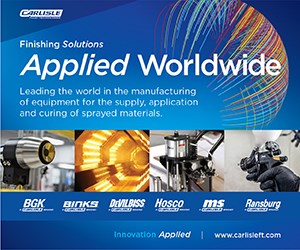Using Alternatives in Pretreatment Baths for Degreasing
Effective cleaning at low, even ambient temperatures, is possible, says Atotech’s Brandon Lloyd, and creates a safer work environment and reduces energy demands.
Q: We have been using the same degreasing product for many years and it works relatively well for us, but it has a short bath life and operates around 150oF. After about a month, our parts are no longer cleaned effectively. What alternatives are available?
A: Properly cleaning a substrate surface is essential in achieving a high quality painted part. Without removing the soils (whether organic or inorganic), it is very difficult or impossible to form a desirable coating on the surface. The industry transition from phosphate conversion coatings to the more sustainable thin-film coatings (such as zirconium and silanes) have increased the importance of consistent substrate cleaning. Shortcomings in pretreatment quality contribute to costly paint defects and are a burden on operational efficiency.
Conventional cleaners, similar to yours, do typically operate at higher temperatures and tend to have a lower oil loading capacity. These cleaners provide adequate performance when new, but cleaning performance frequently decreases rapidly, resulting in a short bath life, increased defects and higher operational costs. With a shorter bath life, the frequency of new makeups increases, resulting in greater waste disposal or wastewater treatment costs. To maintain a system at higher operating temperatures, the amount of energy required is exponentially greater than a lower temperature process. To counter the low-oil capacity issues, auxiliary equipment can be implemented, which results in additional costs and maintenance.
New-generation cleaners are capable of resolving many deficiencies associated with conventional cleaners. Development and implementation of more sophisticated surfactant packages offer many benefits to applicators – most notably through extended bath life. Additional benefits include increased productivity, wastewater treatment and chemical savings, and improvement in part quality by maintaining stable performance over a longer duration. Effective cleaning at low temperatures, even ambient temperatures, is possible. This creates a safer work environment and reduces energy demands, resulting in improved operating costs.
Q: Some of our parts have welds and laser cuts which are frequently the culprit of many defects or rework. Currently, we ignore these areas because it is difficult to remove the scale formed during welding and laser cutting. Offering our customers a higher performing solution would allow us to expand our business. How can we achieve this?
A: Inorganic scales, such as the oxides formed during welding and laser cutting, impede the entire pretreatment process from operating optimally. Cleaning organic soils near the welds and laser cuts is often poor, and the formation of a conversion coating does not occur on the inorganic scales. For paints, inorganic scales pose several issues. The presence of scale impedes the paint from adhering to the base metal (much like conversion coatings), resulting in premature corrosion. Additionally, the silica inclusions formed during the welding process prohibit full coverage in ecoat applications, thereby increasing the possibility of premature corrosion. Some applicators attempt to resolve this by applying more paint on the parts, but this increases cost and does not always improve the impact resistance of the paint at the scaled areas.
Some applicators implement methods for removing weld and laser scale, such as acid pickles and mechanical means (media blasting, grinding), but there are significant disadvantages associated with each of those. Acid pickles pose a safety threat to employees, if not operated properly or with the appropriate precautions and personal protective equipment. They also have a short bath life as the scales build up in the solution, which then must be waste treated or shipped off-site for disposal. In considering media blasting, the removal of weld and laser scale can be effective in some applications. However, it can result in damage to the substrate surface, impregnate soils if dirty media is used and has line-of-sight issues for complex part geometries. Manual grinding also damages and alters the substrate surface, is not ideal for small components and is a significant hazard for operators.
Developments in chemical descaling technologies have increased in recent years, as applicators realize the safest and most cost-effective way to improve oxide removal is within the pretreatment sequence. Modern descaling chemistries offer much greater process versatility (operating in both immersion and spray applications); are free of many hazardous or regulated substances, such as phosphoric acid, fluoride, nonylphenol ethoxylates and hard chelating agents; and may even have built-in surfactant packages to support improved cleaning. Notable advancements include neutral pH descalers for improved employee safety and reduced equipment damage from exposure to corrosive acids.
Brandon Lloyd is global product manager for paint pretreatment technologies at Atotech. Stephen Taylor, North American product marketing manager, contributed. Visit Atotech.com.
Related Content
Trends in Industrial Coatings
The benefits of new technologies in the industrial coatings market.
Read MoreThe Real Cost: C-Hooks Versus Parts Racks
Industrial finishing line consultant Dan Davitz discusses the advantages of parts rack over the use of C-hooks for your paint or powder coating line.
Read MoreSmart Automotive Paint Booths: Embracing Industry 4.0
Automation, digitization, connectivity, remote process management tools help automakers, suppliers paint parts, vehicles at lower cost, reduced carbon footprint.
Read MoreHenry Ford Is Still Right When It Comes to Color
Who would have imagined that more than 100 years after his famous statement about any color as long as it’s black would still have relevance of a sort?
Read MoreRead Next
Powder Coating 4.0: Smarter, Faster, More Efficient and Connected
New tools reduce cost and waste, lower manufacturing footprint of powder coating operations.
Read MoreThe 2024 Ford Mustang: All the Colors Available
Although Chevrolet has announced the end of the Camaro and Dodge is offering “Last Call” editions of the Charger and Challenger, the Ford Mustang is launching to its seventh generation.
Read MoreEpisode 42: An Interview with Robin Deal, Hubbard-Hall
Hubbard-Hall wastewater treatment specialist Robin Deal discusses the latest trends in wastewater management.
Read More

























